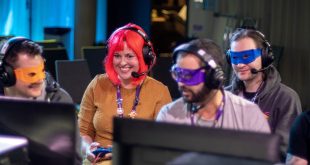 Vince Pavey talks to Josh Grier, COO and co-founder at Ember Lab about turning an animation studio into a video game studio and developing a hit video game all at once, as the pair avoid evil spirits ahead of Develop:Brighton.
Vince Pavey talks to Josh Grier, COO and co-founder at Ember Lab about turning an animation studio into a video game studio and developing a hit video game all at once, as the pair avoid evil spirits ahead of Develop:Brighton.
Kena: Bridge of Spirits is a game that was one of PlayStation’s biggest exclusive releases of 2021, but at the start of its development, the team behind the title had never even attempted a game before. An animation studio changing its production strategy and putting its focus on another medium could’ve been a disastrous move, but the team at Ember Lab somehow pulled it off.
The final game is a well-paced action adventure that combines fast paced combat while provoking a feeling of exploration, challenging puzzles, and high-quality filmic storytelling. It is however, one that is a fair amount shorter than its contemporaries (which frankly in a time where many releases are feeling bloated and padded-out is a welcome change) and it turns out even that is by design.
“We set out to make a story-focused, action adventure game in a smaller but AAA quality package, and we pitched an experience that was digestible – something you could complete in a weekend, but with high quality visuals and really fun gameplay,” says Josh Grier, COO and co-founder at Ember Lab. “All in all, we stayed true to that pitch. Kena: Bridge of Spirits is a story driven adventure game, with rich environments to explore and challenging combat. Indeed, the combat is not for the faint of heart, and it should give more experienced gamers some exciting and memorable moments.”
That desire to create a story driven adventure game meant a fast transition for the team, away from the creation of animation for external clients in other industries, and into a game development firm in its own right. Thankfully, the team possessed a great deal of passion for games that could be harnessed to drive towards their goal.
“The studio’s original background was in commercials and VFX, but we’ve always wanted to tell our own unique stories,” explains Grier. “The team is full of gamers, so we were naturally attracted to games because they allow for such an immersive experience. We originally considered making Kena’s story a short film, or an animated short, but as we started to develop the characters and the storyline we began to envision gameplay mechanics that could work really well with the story we were telling.
“Making a game was a new challenge for us but we felt that we could leverage our skills in animation and VFX to create a prototype to pitch. It’s fair to say, though, we never in a million years dared to dream it would become this popular. We found inspiration in many things along the way, including eastern philosophy and art, themes of finding balance, letting go, and traditional Balinese music called Gamelan.
“On the games front, we were always drawn to adventure games such as Legend of Zelda, but we have gained a lot of inspiration from the world around us as well,” says Grier. “Mike, the creative director on Kena, drew on his experiences of living in Japan and exploring the countryside, which is evident in the lush, detailed environments. Our diverse team brings a variety of influences, and you can see aspects of many cultures in our character designs and music.”

A NOT-SO TERRIBLE FATE
It’s probably unsurprising for a company that started out as an animation studio, that popular films, cartoons and anime were also key touchstones during development.
“Outside of games, we were always drawn to heavily art-directed films like Lord of the Rings and Blade Runner, and the unique and often whimsical animated worlds of Studio Ghibli,” adds Grier. “Also, personally speaking, growing up with a father who worked for the Walt Disney Company meant that not only was I immersed in fantasy, storytelling, and creative engineering from a young age, but also living abroad gave insights into different cultures, environments, and stories. I’d definitely put Disney animated films from the 90’s as another big influence.”
In its earlier days, Ember Lab was also behind a The Legend of Zelda: Majora’s Mask fan film called ‘Terrible Fate’, which went viral back in 2016. The short was well made and actually helped the team with the recognition it needed from prospective development partners in the games industry.
“The success of the Terrible Fate film certainly helped when we were pitching Kena,” affirms Grier. “Because we were new to the game development world, most people were not familiar with Ember Lab as a studio. However, we could usually mention the Terrible Fate short and people would instantly recognize the work. This helped us build a bit of an identity as we were trying to share insights about the studio and build excitement around our new project.”
Positive associations aside, Kena was still being developed by a green developer without much experience, so making a strong prototype and pitch-deck was important when it came to getting funding, and ultimately led to a team up with PlayStation.
“Pitching and fundraising is always hard. When we pitched Kena, we were an unproven team taking on an ambitious project and had never made a game before,” says Grier. “In addition to our pitch materials we had a strong prototype that really helped build some confidence in our team’s abilities. Even with those materials we had a lot of convincing to do and it took us about ten months to secure funding. But, ultimately we found an amazing partner in PlayStation who believed in the team and gave us tremendous support along our journey.”

GAME FEEL PRIORITIES
While good animation was a given from Ember Lab, making sure that the game felt good to play was understandably a focus for the studio right from the start.
“Character control was a key priority early on. We wanted to make sure playing as Kena felt rewarding, responsive, and fun to control,” says Grier. “Another important aspect was finding ways to make sure Kena’s relationship with her spirit companions felt integrated and cohesive. Our goal was to make Kena feel at her best when she and the Rot work together to defeat enemies, solve puzzles, and navigate the world. We put a lot of resources into environmental interactions with the Rot to really bring this home.”
The balance between putting a spotlight on good, high-quality animation and still ensuring that the player would have fun with the gameplay took a while, and play-testing was crucial as they made changes.
“Our animation team did an amazing job learning to adjust and improve their animation style to always prioritise player feel and Kena’s responsiveness,” explains Grier. “The team spent a lot of time tuning Kena’s move set and attacks to make sure the character controller felt fluid and fun to play. Testing player feedback and iteration were the key to creating Kena’s move set. It was a detailed process, but one that we felt was critical to the overall quality of the experience.”
The earliest versions of Kena: Bridge of Spirits had lots and lots of resource bars to keep track of, and the development team ultimately simplified the systems. Making things less complex in order to make the combat more satisfying in the moment-to-moment also meant a player’s focus would be more on the beauty of the game world and its inhabitants than a complicated on-screen UI, or the stress of resource management.
“We always knew that we wanted to lean towards a subtle UI direction with visual feedback in the world as primary indicators,” says Grier. “It was a goal of ours from the beginning, but we weren’t able to get there initially because we needed to wait until more of the art and environmental assets were complete before we could determine how to integrate this feedback without needing as many complex UI systems. These changes came in toward the end of development and elevated the experience. We were really happy with how the visual feedback impacted the immersion of gameplay.”
While Kena started out on Unity, development soon shifted over to Unreal Engine for a myriad of reasons, including a focus on art, and a lack of code know-how.
“Ultimately, we looked to Unreal because at the time it had more tools for artists to create content,” explains Grier. “The workflow in Unreal shared some similarities to our VFX pipelines and our team picked it up relatively quickly. The introduction of the blueprint tools in the engine also allowed us to prototype quickly and effectively without the need for significant engineering support.
“During the prototype development, our team was very small and unfortunately, we did not have any programmers in-house at the studio. Ultimately, we needed a really strong engineering team to create the game but prior to funding we had to work with what we had. Unreal allowed us to maximise the strengths of our prototype team.”

STARTING OVER
“If we had to start over again on Kena, I’d do a lot of things differently,” muses Grier. “As a first game, we made plenty of mistakes, but the most important thing is to learn from them. If we were to start over, we’d try to plan features in more detail on paper before standing up certain systems. Iteration is much easier in this phase. We also would have loved to dedicate more resources that could empower artists and designers.
“We did a lot of tedious work on Kena that could have been mitigated by investment in better tools early on. We’re also very used to verbal communication working well with a small team, but going through development during COVID really exposed the limitations of our communication style. We learned the value of effective documentation throughout development, but we really wish we had started documenting things more thoroughly early on.”
Other lessons learned involve planning just as much for at the end of development when you have to sell your game, as they do when getting things right at the beginning.
“The last 10-15%, to get the game up to shipping quality, is going to be really hard and will take longer than expected. Try to build in contingency for that last push,” says Grier. “Also, as an indie developer, you can’t forget about allotting time to marketing your game. Plan ahead for trailers and promotional content. Don’t underestimate the amount of time needed to create quality marketing materials. They are really important to help tell your story and share what makes your game worth playing.”
Grier has been vocal in other interviews about the fact that the studio often delayed QA on Kena in order to present higher quality software to testers, which he admits was probably a mistake.
“During development we often found ourselves feeling like we needed to push back playtesting to ‘sneak’ features in, or polish elements of the game,” he explains. “It’s always a balance, but we definitely waited too long while working on Kena. So, one of the obvious learnings for us was to get people playing the game even when it feels too early. Another learning was the feedback even on unfinished features can be really helpful to guide decisions later in development.”
Overall though, the studio co-founder is happy with the way Kena has been received by players. Sadly, he’s also tight-lipped on what the studio is working on next, outside of confirming what might be obvious – that the team has already started throwing ideas around.
“It was amazing to see the positive response from players and fans – it definitely made it all worth it,” explains Grier. “In particular, many players expressed an interest in exploring more of the world, the history, and Kena’s backstory, which really touched us given the game’s focus on story and character. It gives us more confidence to continue diving deep next time, and continue pushing those aspects forward.
“While we supported Kena last year for our Steam launch and Anniversary DLC we continued exploring new concepts and ideas for our next project. We have not settled on exactly what we are going to develop but we are definitely excited to continue making more games.”

 MCV/DEVELOP News, events, research and jobs from the games industry
MCV/DEVELOP News, events, research and jobs from the games industry




